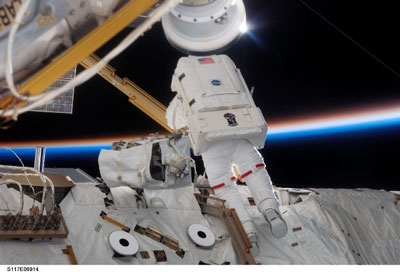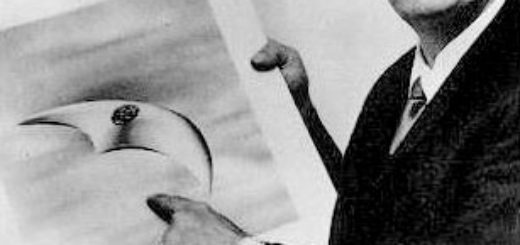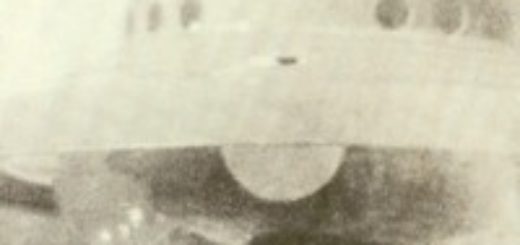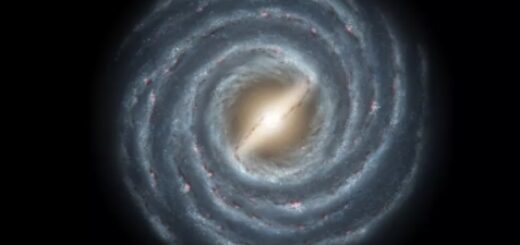Why is a baby monitor picking up video of the space shuttle?

For several days, astronauts on the International Space Station and Russian and American space administrators have been trying to figure out what’s causing some of the station’s vital computer systems to fail. Although there’s no danger to the astronauts’ life-support systems, the failed computers control the thruster system, which controls the station’s orientation. The problem may be linked to the recent installation of new solar arrays. Fortunately, while the space shuttle Atlantis is docked with the space station, its thrusters can be used to alter the station’s orientation. (The station’s orientation is periodically changed so that its solar panels get the maximum possible amount of energy from the sun.)
There are three crew members and seven shuttle astronauts on the station right now. NASA has stated that there’s only a very small chance that the station would be evacuated. The current computer failure is unprecedented, but fortunately it’s not considered especially dangerous for the lives of the crew or the future of the station.
Back on Earth, a bewildering saga is unfolding in Palatine, Illinois that relates to the problems on the ISS. Natalie Meilinger, a science teacher, owns a baby monitor that has been picking up a live video feed from Atlantis on one of its two channels. A NASA spokeswoman said that Meilinger’s baby monitor isn’t picking up the feed directly from the space shuttle and that she hadn’t heard of a similar occurrence in the past.
The video feed is one of four (three video and one audio) produced by NASA for the public. Space-shuttle fans can watch the feeds, including the one available on Meilinger’s baby monitor, on NASA’s Web site.
For the Meilingers, the video has made for great entertainment in addition to a little bit of intrigue. Speaking to the Associated Press, Natalie Meilinger said, “I’ve been addicted to it and keep waiting to see what’s next” [Source: CNN].
The baby monitor’s manufacturer, Summer Infant, doesn’t know the cause of the electronic eavesdropping. However, we were intrigued, so we did a little research. Read on to find out what we think may be causing the baby monitor to be picking up the space shuttle’s video feed.
So what’s causing the baby monitor to pick up the NASA video? In the past, we’ve written about how people might be able to listen in on audio-only baby monitors. In this case, it all comes down to what the Meilingers’ video baby monitor really is: a TV, complete with built-in antenna. Before we go into the details of what’s happening here, let’s talk a bit about radio and television frequencies.
Most people get their TV through cable or satellite. However, some still get their TV the old fashioned way through direct reception, which requires an antenna to pick up the TV signal broadcast through the air. With the inception of television, a large number of radio frequencies were set aside to broadcast TV. Early on, television was limited to channels 2 through 13, which were called Very High Frequency (VHF) channels. After World War II, more channels were assigned for TV use; these were called Ultra High Frequency (UHF) channels.
In recent years, due to the proliferation of so many different types of over-the-air communication — including radio, television, cell phones, military communications and WiFi — some channels have been reassigned to other uses. Today, channels 2 through 13 are still VHF channels. Channels 14 through 69 are UHF channels. Channels 70 through 83 were reassigned to cell phone frequencies in the early 1980s, and in 2009, channels 52 through 69 will be reassigned to broadcast HD channels.
In the next section, we’ll see how all of this fits into the mystery.



 Creators of mankind
Creators of mankind Description of “Tall white aliens”
Description of “Tall white aliens” Where they came from?
Where they came from? About hostile civilizations
About hostile civilizations The war for the Earth
The war for the Earth “Tall white aliens” about eternal life
“Tall white aliens” about eternal life Video: “Nordic aliens”
Video: “Nordic aliens” Aliens
Aliens Alien encounters
Alien encounters The aliens base
The aliens base UFO
UFO Technology UFO
Technology UFO Underground civilization
Underground civilization Ancient alien artifacts
Ancient alien artifacts Military and UFO
Military and UFO Mysteries and hypotheses
Mysteries and hypotheses Scientific facts
Scientific facts


















